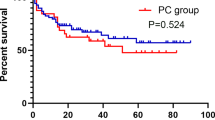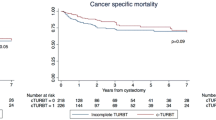Abstract
Purpose
We aimed to evaluate whether maximal transurethral resection (TUR) affects the oncological outcome of partial cystectomy (PC) performed in patients with muscle-invasive bladder cancer (MIBC), although radical cystectomy (RC) and trimodal therapy (TMT) are regarded as standard treatments for MIBC.
Methods
In this retrospective study, we evaluated the data of 98 patients who underwent PC due to MIBC between January 2006 and December 2018. Of the 98 patients, 71 underwent maximal TUR. We evaluated the recurrence-free survival (PFS), pelvic recurrence-free survival (pPFS), cancer-specific survival (CSS), and overall survival (OS) using the Kaplan–Meier method according to the maximal TUR status. Variables associated with survival were analyzed using Cox regression analyses.
Results
The 5-year PFS (42.5% vs. 20.3%, p = 0.008), pPFS (50.7% vs. 24.1%, p = 0.003), and CSS (74.0% vs. 51.0%, p = 0.016) were also higher in patients who underwent maximal TUR. The multivariable Cox regression analysis showed that maximal TUR was associated with PFS (hazard ratio [HR] = 0.500, p = 0.029), pPFS (HR = 0.353, p = 0.004), and CSS (HR = 0.416, p = 0.027). However, maximal TUR did not affect the OS (HR = 0.618, p = 0.132).
Conclusion
PC resulted in acceptable oncological outcomes in patients with MIBC, while maximal TUR played an important role in improving the oncological outcomes. PC after maximal TUR can be suggested as a treatment option for MIBC patients who are unable to undergo RC and TMT.

Similar content being viewed by others
References
Bray F, Ferlay J, Soerjomataram I, Siegel RL, Torre LA, Jemal A. Global Cancer Statistics 2018: GLOBOCAN Estimates of Incidence and Mortality Worldwide for 36 Cancers in 185 Countries. CA Cancer J Clin. 2018;68(6):394–424.
Ham WS, Park JS, Jang WS, Choi YD, Kim J. Prognostic Value of Prostate Volume in Non-muscle Invasive Bladder Cancer. Sci Rep. 2021;11(1):18784.
National Comprehensive Cancer Network. Bladder cancer (Version 2.2022). Accessed 5 June 2022. https://www.nccn.org/professionals/physician_gls/pdf/bladder.pdf
Witjes JA, Bruins HM, Cathomas R, et al. European Association of Urology Guidelines on Muscle-invasive and Metastatic Bladder Cancer: Summary of the 2020 Guidelines. Eur Urol. 2021;79(1):82–104.
Svatek RS, Fisher MB, Matin SF, et al. Risk Factor Analysis in a Contemporary Cystectomy Cohort Using Standardized Reporting Methodology and Adverse Event Criteria. J Urol. 2010;183(3):929–34.
Hirobe M, Tanaka T, Shindo T, et al. Complications Within 90 Days After Radical Cystectomy for Bladder Cancer: Results of a Multicenter Prospective Study in Japan. Int J Clin Oncol. 2018;23(4):734–41.
Maibom SL, Røder MA, Poulsen AM, et al. Morbidity and Days Alive and Out of Hospital Within 90 Days Following Radical Cystectomy for Bladder Cancer. Eur Urol Open Sci. 2021;28:1–8.
Zhou N, Tian F, Feng Y, et al. Perioperative Outcomes of Intracorporeal Robot-Assisted radical Cystectomy Versus Open Radical Cystectomy: A Systematic Review and Meta-Analysis of Comparative Studies. Int J Surg. 2021;94:106137.
Choi H, Park JY, Bae JH, Tae BS. Health-Related Quality of Life After Radical Cystectomy. Transl Androl Urol. 2020;9(6):2997–3006.
Kulkarni GS, Hermanns T, Wei Y, et al. Propensity Score Analysis of Radical Cystectomy Versus Bladder-Sparing Trimodal Therapy in the Setting of a Multidisciplinary Bladder Cancer Clinic. J Clin Oncol. 2017;35(20):2299–305.
Kimura T, Ishikawa H, Kojima T, et al. Bladder Preservation Therapy for Muscle Invasive Bladder Cancer: The Past, Present and Future. Jpn J Clin Oncol. 2020;50(10):1097–107.
Kassouf W, Swanson D, Kamat AM, et al. Partial Cystectomy for Muscle Invasive Urothelial Carcinoma of the Bladder: a Contemporary Review of the M. D. Anderson Cancer Center Experience. J Urol. 2006;175(6):2058–62.
Chang SS, Cookson MS, Baumgartner RG, Wells N, Smith JA Jr. Analysis of Early Complications After Radical Cystectomy: Results of a Collaborative Care Pathway. J Urol. 2002;167(5):2012–6.
Chung R, Moran GW, Wang C, McKiernan JM, Anderson CB. Partial Cystectomy: Review of a Single Center Experience from 2004 to 2019. Urol Oncol. 2022. https://doi.org/10.1016/j.urolonc.2022.09.003.
Stein JP, Lieskovsky G, Cote R, et al. Radical Cystectomy in the Treatment of Invasive Bladder Cancer: Long-Term Results in 1,054 Patients. J Clin Oncol. 2001;19(3):666–75.
Capitanio U, Isbarn H, Shariat SF, et al. Partial Cystectomy does not Undermine Cancer Control in Appropriately Selected Patients with Urothelial Carcinoma of the Bladder: A Population-Based Matched Analysist. Urology. 2009;74(4):858–64.
Michaelson MD, Hu C, Pham HT, et al. A Phase 1/2 Trial of a Combination of Paclitaxel and Trastuzumab With Daily Irradiation or Paclitaxel Alone With Daily Irradiation After Transurethral Surgery for Noncystectomy Candidates With Muscle-Invasive Bladder Cancer (Trial NRG Oncology RTOG 0524). Int J Radiat Oncol Biol Phys. 2017;97(5):995–1001.
Coen JJ, Zhang P, Saylor PJ, et al. Bladder Preservation With Twice-a-Day Radiation Plus Fluorouracil/Cisplatin or Once Daily Radiation Plus Gemcitabine for Muscle-Invasive Bladder Cancer: NRG/RTOG 0712-A Randomized Phase II Trial. J Clin Oncol. 2019;37(1):44–51.
Holzbeierlein JM, Lopez-Corona E, Bochner BH, et al. Partial Cystectomy: A Contemporary review of the Memorial Sloan–Kettering Cancer Center Experience and Recommendations for Patient Selection. J Urol. 2004;172(3):878–81.
Smaldone MC, Jacobs BL, Smaldone AM, Hrebinko RL Jr. Long-Term Results of Selective Partial Cystectomy for Invasive Urothelial Bladder carcinoma. Urology. 2008;72(3):613–6.
Golombos DM, O’Malley P, Lewicki P, Stone BV, Scherr DS. Robot-Assisted Partial Cystectomy: Perioperative Outcomes and Early Oncological Efficacy. BJU Int. 2017;119(1):128–34.
Chung R, Moran GW, Wang C, McKiernan JM, Anderson CB. Partial Cystectomy: Review of a Single Center Experience from 2004 to 2019. Urol Oncol. 2022;40(12):538.e1-e5.
Hussein AA, Elsayed AS, Aldhaam NA, et al. Ten-Year Oncologic Outcomes Following Robot-Assisted Radical Cystectomy: Results from the International Robotic Cystectomy Consortium. J Urol. 2019;202(5):927–35.
Ham WS, Rha KH, Han WK, et al. Oncologic Outcomes of Intracorporeal vs Extracorporeal Urinary Diversion After Robot-Assisted Radical Cystectomy: A Multi-Institutional Korean Study. J Endourol. 2021;35(10):1490–7.
Zhan X, Chen T, Jiang M, et al. A Novel Nomogram and Risk Classification System Predicting the Cancer-Specific Survival of Muscle-Invasive Bladder Cancer Patients after Partial Cystectomy. J Oncol. 2022;2022:2665711.
James AC, Lee FC, Izard JP, et al. Role of Maximal Endoscopic Resection Before Cystectomy for Invasive Urothelial Bladder Cancer. Clin Genitourin Cancer. 2014;12(4):287–91.
Knoedler JJ, Boorjian SA, Kim SP, et al. Does Partial Cystectomy Compromise Oncologic Outcomes for Patients with Bladder Cancer Compared to Radical Cystectomy? A matched case-control analysis. J Urol. 2012;188(4):1115–9.
Grossman HB, Natale RB, Tangen CM, et al. Neoadjuvant Chemotherapy Plus Cystectomy Compared with Cystectomy Alone for Locally Advanced Bladder Cancer. N Engl J Med. 2003;349(9):859–66.
Pfister C, Gravis G, Fléchon A, et al. Dose-Dense Methotrexate, Vinblastine, Doxorubicin, and Cisplatin or Gemcitabine and Cisplatin as Perioperative Chemotherapy for Patients With Nonmetastatic Muscle-Invasive Bladder Cancer: Results of the GETUG-AFU V05 VESPER Trial. J Clin Oncol. 2022;40(18):2013–22.
Bazzi WM, Kopp RP, Donahue TF, et al. Partial Cystectomy after Neoadjuvant Chemotherapy: Memorial Sloan Kettering Cancer Center Contemporary Experience. Int Sch Res Notices. 2014;2014:702653.
Lenis AT, Fero KE, Ojeaburu L, et al. The Role of Neoadjuvant Chemotherapy, Lymph Node Dissection, and Treatment Delay in Patients with Muscle-Invasive Bladder Cancer Undergoing Partial Cystectomy. Urol Oncol. 2021;39(8):496.e17-e24.
Ferro M, Di Lorenzo G, Buonerba C, et al. Predictors of Residual T1 High Grade on Re-Transurethral Resection in a Large Multi-Institutional Cohort of Patients with Primary T1 High-Grade/Grade 3 Bladder Cancer. J Cancer. 2018;9(22):4250–4.
Ferro M, Vartolomei MD, Cantiello F, et al. High-Grade T1 on Re-Transurethral Resection after Initial High-Grade T1 Confers Worse Oncological Outcomes: Results of a Multi-Institutional Study. Urol Int. 2018;101(1):7–15.
Kumarasegaram V, Drejer D, Jensen JB. Detection Rate of Carcinoma In Situ During TURBT Following Shift from Photodynamic Diagnosis to Narrow Band Imaging in a Single University Hospital. Urology. 2022;161:83–6.
Funding
This work was supported by a grant from the Korea Health Technology R&D Project through the Korea Health Industry Development Institute (KHIDI), funded by the Ministry of Health and Welfare, Republic of Korea [Grant Number: HI17C1095], the National Research Foundation of Korea (NRF) grant funded by the Korea government (MSIT) [Grant Number: 2019R1A2C1002863 and 2022R1A2C2003831], and a faculty research grant from Yonsei University College of Medicine (6-2021-0106).
Author information
Authors and Affiliations
Corresponding author
Additional information
Publisher's Note
Springer Nature remains neutral with regard to jurisdictional claims in published maps and institutional affiliations.
Rights and permissions
Springer Nature or its licensor (e.g. a society or other partner) holds exclusive rights to this article under a publishing agreement with the author(s) or other rightsholder(s); author self-archiving of the accepted manuscript version of this article is solely governed by the terms of such publishing agreement and applicable law.
About this article
Cite this article
Ham, W.S., Park, J.S., Jang, W.S. et al. Role of Maximal Transurethral Resection Preceding Partial Cystectomy for Muscle-Invasive Bladder Cancer. Ann Surg Oncol 31, 1384–1392 (2024). https://doi.org/10.1245/s10434-023-14449-5
Received:
Accepted:
Published:
Issue Date:
DOI: https://doi.org/10.1245/s10434-023-14449-5




